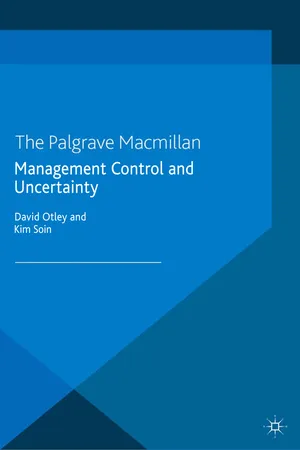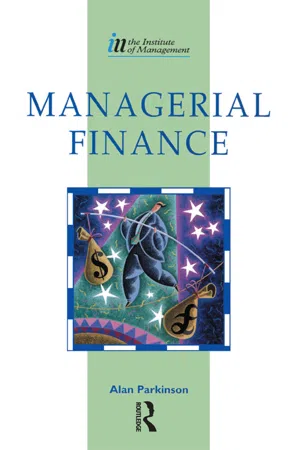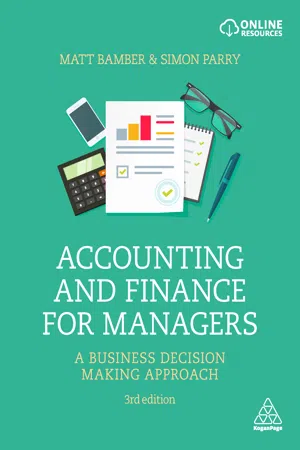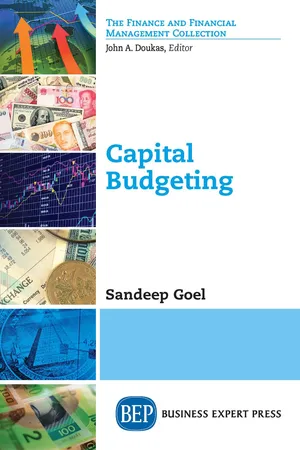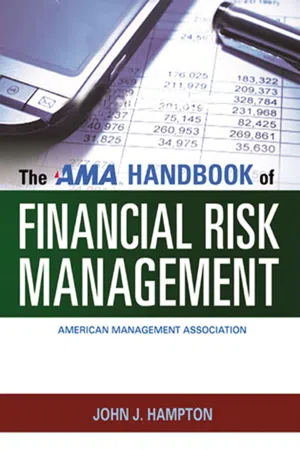Business
Investment Decisions
Investment decisions refer to the process of allocating resources, such as capital, with the expectation of generating future returns. These decisions involve evaluating potential opportunities, assessing risks, and determining the most effective use of funds to achieve the organization's objectives. Effective investment decisions are crucial for business growth and sustainability.
Written by Perlego with AI-assistance
Related key terms
12 Key excerpts on "Investment Decisions"
- eBook - ePub
- M. Association, D. Otley, K. Soin(Authors)
- 2014(Publication Date)
- Palgrave Macmillan(Publisher)
11 Feel the Risk: Strategic Investment Decisions in an Uncertain World Elaine Harris IntroductionThis chapter focuses on risk in strategic decision-making in organizations and draws together a variety of theoretical perspectives, especially from the field of psychology. It explores the notion of “feeling the risk”, which may be unfamiliar to both scholars in management control and practitioners.It is clear that no single theory is adequate to describe or inform how strategic decisions are made in uncertain conditions, but there are several that offer partial explanations or at least contribute towards our understanding of how managers can deal with the uncertain environment and assess the likely risks in strategic decision-making in organizations. The literature suggests how relevant theories might be aggregated to make sense of decision-making in an organizational context and considers the implications for further research in this important area of management control.For this purpose, a strategic investment decision (SID) is defined as an allocation of the firm’s capital to a specific business activity or project in pursuance of the organization’s goals. In corporate strategy terms this involves selecting a strategic option, in financial management it may be termed capital budgeting or capital investment appraisal. It may involve raising new capital or loans to finance the project and to be termed strategic will play a significant role in delivering the corporate goals. A strategic decision may be differentiated from operational decision-making, by the latter being more routine, involving a smaller investment of funds and usually a shorter payback period.Strategic decision-making (SDM) or project appraisals generally require an evaluation of the likely outcomes, both positive and negative, in terms of the financial and non-financial consequences that are predicted to flow from an initial commitment of capital (Harris et al., 2009). Although the future cannot be accurately predicted, decisions must be made with limited information in conditions of uncertainty. Some outcomes can be foreseen with some certainty, especially where we have knowledge and experience of making similar decisions in the past – these we call risks, which may be “calculated” in some sense. Others may be less foreseeable, so stay within the realm of “uncertainty”. - eBook - ePub
- D. Crowther(Author)
- 2007(Publication Date)
- Routledge(Publisher)
Another factor which influences business decisions regarding capital investment is the effect of tax regulations upon the decision. These regulations can affect such decisions because the extent to which capital allowances are given and the timing of the tax payments on costs incurred can make a significant difference to a business in deciding when and how to undertake capital investment. The effect of taxation on such decisions is a complex subject which is outside the scope of this book – and in any case the precise rules affecting tax change on a regular basis. We shall therefore ignore the effects of taxation in our consideration of capital Investment Decisions.Cost of Capital and Capital Investment DecisionsMoney is a scarce resource and the owners of capital, be they shareholders or long-term lenders, require a return commensurate with the risks involved. The return which investors seek will affect the firm’s cost of capital and the return which any new investment project must earn in order to meet investor’s expectations.The cost of capital will vary from one company to another. It is determined by the return which investors expect to earn from the company given its financial and economic risk and other macroeconomic factors such as the level of current and forecasted interest rates and investor’s expectations of the future prospects for corporate earnings.Investment Decisions have the most profound effects on a firm’s future survival and success. In order for a business to stay competitive, and ahead of the game, it must invest in a wide range of tangible and intangible assets. Investment Decisions are central to the firm, and firms have to consider what are often large proposals for capital expenditure with the greatest care. Sub-optimal Investment Decisions could damage the firm’s long-term viability and therefore it is crucial that there is a logical and practical way of assessing capital investment projects.In order for management to make good Investment Decisions they must be able to either find assets which are currently undervalued, invent new products or realise that an existing service could be radically altered thereby bringing new benefits to consumers and higher returns to the owners. It is these types of decisions which will enhance the value of the firm. Wealth can only be created if the future benefits exceed the cost of owning the asset that is expected to generate more benefits. - eBook - ePub
- Alan Parkinson(Author)
- 2012(Publication Date)
- Routledge(Publisher)
The significance of the capital investment decision is thus clear. The reasons rationalizing the significance apply to longer term Investment Decisions in general although their degree of significance, and thus their degree of influence upon decision-making, will vary according to the particular type of decision and organizational activity being looked at. A common feature that all capital budgeting decisions have with shorter term investments is that managers are looking at making investments which will (hopefully!) produce returns. The distinction is that the longer term investment decision will produce returns over a number of future time periods rather than the current period returns which arise from other types of decisions.Capital Investment Decisions will generally be concerned with the planning for and management of activities such as:- the acquisition of fixed assets such as land and buildings, plant and equipment and vehicles (be it a first-time or replacement acquisition)
- investment in a special project such as a marketing/advertising campaign or research and development
- the expansion of current facilities, be they production or administrative or in relation to any other
- entry into new product/service provision
- investment in development of managers, such as yourself, through training and education.
Such Investment Decisions are never easy Often, given the long-term nature of the decision consequences, the projected outcomes and associated returns are at best uncertain and at worst unpredictable and/ or intangible. Given this scenario it is understandable that many managers seek advice from all quarters as an aid to reducing the risk of making the wrong capital Investment Decisions. What they invariably seek is a framework, at least from a financial angle.A framework for predicting the future
If you as a manager had the opportunity to design an appropriate advisory framework from scratch, it is likely that you would wish the design to help you to solve certain key problems which might hamper your effective decision-making. Perhaps the two key problems needing remedies might be: - eBook - ePub
Property Investment Decisions
A quantitative approach
- S Hargitay, S. Hargitay, S-M Yu(Authors)
- 2003(Publication Date)
- Routledge(Publisher)
Part One Property Investment DecisionsPassage contains an image
1 The rationale of investment and investment decision-making
DOI: 10.4324/9780203473849-3- 1.1 Introduction
- 1.2 Principles of investment
- 1.3 The investment problem
- 1.4 Towards the management of the investment problem
- 1.5 Types of investment
- 1.6 The investors and market makers
- 1.7 Classification of Investment Decisions
- 1.8 The investment decision-making process
- 1.9 Summary
1.1 Introduction
This chapter reviews the fundamentals of investment as a wealth-generating activity. The investment problem and its management will be considered, together with the principal players, the decision-makers in this important economic activity. After the classification of the Investment Decisions, the investment decision-making process will be considered in detail.1.2 Principles of investment
The fundamentals of investment must be preceded by an attempt at defining investment as an economic activity. Investment is to do with the creation, enlargement and protection of wealth.Investment involves the commitment of a capital sum for benefits to bllows: Investment is the utilization of capital resources for maximum possiblereward.Funds are committed to various ventures whice received in the future in the form of an income flow or capital gain or a combination of both. As an economic activity, investment may be defined as foh promise attractive returns at the price of risking a partial or total loss of the funds without an absolute guarantee of the size or receipt of returns. Investment therefore represents certain sacrifices for uncertain benefits.Investment has two principal aspects: anticipated return and risk. The return aspect is perhaps the easier one to perceive and measure. It is usually translated into money terms and its size is all-important. The risk aspect, on the other hand, presents serious conceptual and analytical problems. Risk is a difficult concept to perceive and define and its direct measurement is virtually impossible. In an ideal, rational world the investor is expected to live by the maxim: ‘Maximize returnswhilst minimizing risk’ - eBook - ePub
Financial Management
An Introduction
- Jim McMenamin(Author)
- 2002(Publication Date)
- Routledge(Publisher)
part four Strategic Financial Decision-Making The Investment DecisionPart 4 Contains the Following:
• Chapter 10 - Investment Appraisal - Introduction• Chapter 11 - Investment Appraisal - Risk Analysis• Chapter 12 - The Cost of Capital • Case Study 4 - Ocean Blue Hotel In this part we explore the activity which is central to the financial management process — financial decision-making. We begin by examining the firm's most important type of financial decisions, that is, its strategic Investment Decisions. It is the quality of the firm's strategic Investment Decisions which in essence determines its value. Stated simply, good quality Investment Decisions will enhance the firm's value, poor quality decisions will reduce it.Chapter 10 reviews the strategic investment decision-making process, generally under conditions of certainty. Chapter 11 refines this approach by introducing risk, and techniques of risk analysis.Chapter 12 explains the determination of the firm's cost of capital, which is the medium through which the firm's strategic Investment Decisions are connected to its strategic financing decisions.This part then concludes with an integrative case study on strategic investment decision-making.Part 4 diagram The financial management process: financial decision-making —the investment decisionPassage contains an image
Introduction10 Investment AppraisalLearning Objectives
By the end of this chapter you should be able to:- understand the nature of corporate Investment Decisions;
- explain the investment appraisal process;
- apply the main investment appraisal techniques;
- recognise the limitations of the main investment appraisal techniques;
- appreciate the influence of non-financial and intangible factors in investment decision-making.
What Do We Mean by Investment?
The essence of investment is to: 'forego present consumption of resources in order to increase the total amount of resources which can be consumed in the future' (Dixon, 1994 ). Alternatively an investment can be viewed in terms of: 'making an outlay of cash now in the expectation of extra cash coming in the future' (Dixon, 1994 - eBook - ePub
Financial Management
Partner in Driving Performance and Value
- Jack Alexander(Author)
- 2024(Publication Date)
- Wiley(Publisher)
Part Six Valuation and Capital Investment DecisionsPassage contains an image
28 Capital Investment Decisions—Introduction and Key Concepts
Capital Investment Decisions (CIDs) are some of the most important business decisions that managers make. Capital decisions are generally defined as relatively large investments that will have an economic life of several years. We will define capital investments broadly, including purchases of equipment, new product development projects, acquiring a product line or a company, building a factory or distribution center, and many others. The capital investment decision is a determination of whether the project is likely to create value for shareholders. In this chapter, we will introduce capital investments, evaluation and key decision criteria, and outline the steps required to evaluate CIDs. In Chapter 29 , we will cover advanced topics of CIDs, including dealing with risk and uncertainty, monitoring projects, and presenting capital Investment Decisions.THE CAPITAL INVESTMENT PROCESS
A strong capital investment process is critical to ensure a thorough evaluation and decision. Figure 28.1 outlines key steps in an effective capital investment process.Companies should identify potential capital projects as part of their strategic and annual operating planning activities. The capital budget should be an important element of each plan. For strategic plans, the managers should look out three to five years and anticipate significant capital expenditures to support growth, strategic initiatives, and other requirements. Integrating the capital plan into the financial projections will afford the opportunity to review cash flow projections and determine the adequacy of returns over the strategic planning horizon. - Michael Chibili(Author)
- 2019(Publication Date)
- Routledge(Publisher)
15Capital Investment Decisions
15.1 Types of capital budgeting decisions15.2 Basic methods for making Investment Decisions15.3 Simple and compound interest15.4 Process of discounting15.5 Understanding factor tables15.6 Discounted cash flow (DCF) methods15.7 Incidence of taxes on DCF analysis15.8 Choosing between projectsBusinesses are created with the aim of existing forever. For this to become possible, the business must be able to earn profits over a period of years. In this case, short term gains might have to be sacrificed in the interest of long term goals. Decisions that involve the acquisition of equipment, land, buildings, and vehicles are examples of decisions that businesses will periodically have to make that have an influence on their cash flows. In the hospitality industry, the largest investments that are normally made will be about land or building acquisition. However these are not decisions that are made on a day-to-day basis. Whether the opportunity involves building a new hotel, modernizing an old one, or extending a hotel, money must be made available and spent on what might be called a ‘capital investment’ that is expenditure incurred now in order to produce a stream of benefits over a period of years which will, it is hoped, result in the firm being in a more favourable position. Capital Investment Decisions differ from operating decisions by reason of the nature of the expenditure and the length of time before the full effect of the decision is felt.- eBook - ePub
- J. Bridge, J. C. Dodds(Authors)
- 2018(Publication Date)
- Routledge(Publisher)
91 ] begin their first chapter with the words: ‘The defining characteristic of an investment is the outlay of valuable resources in the expectation of future gain’ (p. 3). It is on the assumption that the objective of management, in investment, is a profitability target measured over an appropriate time horizon, that our analysis is developed in the present chapter. The accelerator principle, factor substitution, and flow of funds are certainly relevant but perhaps best regarded as proximate, rather than ultimate, causes of investment.The decision to commit resources for investment purposes is probably the most important decision of management. Indeed if we go back to the hierarchy of decisions introduced in Chapter 1 we argued (following Ansoff [6 ]) that the investment decision is a strategic decision and the responsibility of top management. High level decisions often involve a distant time horizon and this is certainly true of Investment Decisions. Resources are committed at one point in time and the benefits do not accrue until later. The forward looking nature of these decisions means that the whole issue of knowledge: certainty, risk and uncertainty, will be a very important one in the present chapter.The basic condition on which investment proceeds is that in return for paying out, or committing a given amount of resources to a particular project, a larger amount will be received back over a period of time. This amount should not only repay the original outlay but also provide a target rate of return on the outlay. Because the outlay of resources and the benefits derived (often referred to as cash flows or income stream) do not occur simultaneously but arise in different time periods, the whole life of a capital project must be considered in its appraisal. - eBook - ePub
Accounting and Finance for Managers
A Business Decision Making Approach
- Matt Bamber, Simon Parry(Authors)
- 2020(Publication Date)
- Kogan Page(Publisher)
The apparent sophistication and precision of financial investment appraisal techniques can mask shortcomings and behavioural aspects of their application. This chapter therefore includes evaluation of frequently used techniques within a wider behavioural context.Introduction
Investment appraisal is the process of deciding which projects or assets to invest in. In this chapter we will look at how to evaluate investments from a financial point of view and how such financial analysis fits into the overall investment decision process. Investment appraisal should always be understood within the wider context of strategic formulation and implementation. Although such matters are beyond the scope of this textbook, this chapter will look at how non-financial factors, risk levels and wider strategic concerns can impinge upon the more traditional concerns of the immediate economic return from an investment.Investment appraisal, sometimes referred to as capital investment appraisal, is concerned with organizational decisions about investment in equipment, machinery, buildings or other long-term assets. This can include a range of types of decision such as replacement of existing assets, investing in new IT or equipment to reduce operating costs, expansion through purchasing new buildings or equipment, improving delivery service or staff training. However, the principles apply equally to investments in shares in companies, whether made by businesses or individuals. Therefore the techniques looked at in this chapter are equally relevant to both businesses and individuals who are involved in making investments.The importance of good investment appraisal lies with the strategic and financial importance of the investments made. Investments will shape the future of the organization. Such investments often involve large resources. Wrong decisions can be costly and difficult to reverse and will have a direct impact on the organization’s ability to meet its strategic objectives.From a financial point of view, an investment involves making a cash outlay with the aim of receiving future cash flows in return. At a basic level, assessing the financial viability of an investment involves simply comparing costs with benefits, and ensuring that the benefits outweigh the costs. However, in practice this can prove difficult, as identifying and measuring the costs and benefits from an investment can be a complex task. This chapter will address some of the problems of investment cost–benefit analysis and look at how techniques have developed in order to meet these problems. - eBook - ePub
- Sandeep Goel(Author)
- 2015(Publication Date)
- Business Expert Press(Publisher)
The investment decision regarding these assets or proposals is the most challenging and complex. In the long run, the success of an enterprise is judged by the effectiveness with which the management employs the available resources to fixed assets for getting the desired returns.It is worthwhile to mention here that long-term funds are invested in procuring fixed assets. So, capital budgeting decision is, usually, financed by long-term funds. In brief, the capital budgeting decision can be broken down into: a. Allocation of long-term funds among fixed assets/long-term assets, b. Risk analysis of these Investment Decisions, and c. Measurement of the cost of capital. On the basis of preceding discussion, the following basic features of capital budgeting can be drawn: i. Capital budgeting decisions have long-term implications. ii. These decisions involve substantial commitment of funds. iii. These decisions are usually irreversible. iv. These decisions determine the future growth of the firm. v. They involve a high degree of risk. vi. They involve a relatively long-term period between the initial outlay and the anticipated return. The various types of capital Investment Decisions are: • Fresh investment in a long-term asset; • Replacement of an asset; • Expansion of the production capacity; • Diversification of business; • Modernization of existing facilities; • Continuation or discontinuation of an existing product line; • R&D activities. Importance of Capital Budgeting DecisionThe foremost importance is that the capital is a limited resource which is true of any form of capital, whether it is raised through debt or equity. The firms always face the constraint of capital rationing. This may result in the selection of less profitable investment proposals due to budget allocation and resource constraints. So the management should be cautious in deciding whether a particular project is economically acceptable and within the specified limits of the investments to be made during a specified period of time. In case of more than one project, management must identify the most suitable one or a combination of investment projects that will contribute to the value of the firm and profitability. This is the essence of capital budgeting. - eBook - ePub
- Steffen Tolle, Boris Hutter, Patrik Rüthemann, Hanspeter Wohlwend(Authors)
- 2012(Publication Date)
- Wiley(Publisher)
Using a process-based approach, the investment process can be defined as a set of interconnected tasks that are combined in a systematic, logical way. This process involves:- considering the objectives, constraints and preferences of the investor and conditions in the financial market;
- selecting an optimal combination of the available investment alternatives for the investor’s portfolio; and
- adjusting the portfolio in the event of changes to the initial scenario.
This definition says nothing about how the investment process is organized. It only lists those elements that are specific to every investment process, without regard for how many people are involved in its implementation. All investment managers will go through the different phases of the process, whether intentionally or unintentionally.Figure 3.1 The decision-making processTo be successful, an investment process must be:1. Integrated: The individual parts of the process must be linked in a way that decentralized decisions can be coordinated efficiently. In addition, a feedback mechanism needs to be in place, managing the flow of information between the different parts of the process. “Stand-alone solutions” should be avoided at all costs.2. Disciplined: The decision-making processes must be governed by certain principles and rules, which the decision-makers adhere to.3. Repeatable: The process can be repeated continuously and is largely independent of any change in the fundamentals.4. Sustainable: The investment process must be strategic in character, enabling it to be pursued consistently over a lengthy period. At the same time, it must also be possible for the investment process to be developed and refined on an ongoing basis.5. Flexible: A high-quality investment process enables asset managers to deal with a wide range of mandate types and client needs.In this chapter we will describe an integrated investment process that meets these criteria. The process differs in a number of ways from other investment processes. Conscious of the fact that there is no perfect investment process, the approach we have taken shows a possible way of mastering the complexity of wealth management by means of a systematic and integrated methodology. - eBook - ePub
- John Hampton(Author)
- 2011(Publication Date)
- AMACOM(Publisher)
Substantial dollar amounts . These investments are generally made in large projects involving tens or even hundreds of millions of dollars. In terms of dollars alone, capital budgeting decisions are significant to even the largest corporations.• Long time periods . When financial securities are purchased, a decision that is made today can easily be reversed tomorrow. Stock bought on an exchange can be sold, reversing the transaction. This is not the case with the purchase of capital assets. The company is making a long-term decision that is not likely to be reversed in a short period of time.• Loss of liquidity . Money invested in capital assets is not readily available for other purposes. The loss of liquidity adds to the significance of capital budgeting activities.• Over- and undercapacity . If the budget is drawn carefully, it usually improves the timing and quality of asset acquisitions. If it is done poorly, it can cost the firm large sums of money because it leads to overcapacity or undercapacity, sometimes at the same time. The firm may have idle assets to produce a product that is not in demand, but also have a shortage of the machinery and facilities needed to produce a much-demanded, high-profit product.Motives for Investment
A corporation evaluates capital budgeting proposals for several reasons, including:• High profits . Capital investments offer the prospect of high risk and high return. One motive for investing is to earn a high profit.• Growth . By purchasing capital assets that offer potentially high returns, a corporation can accelerate its growth.• Diversification . Many companies operate in cyclical businesses. A company can reduce the risk of large losses in one area by acquiring other lines of business.Ranking of Proposals
Once the capital budget is nearing completion and different projects have been identified, the firm must select the projects it will finance. Among the problems that arise are the following:• Mutually exclusive projects . If the firm accepts one project, it may rule out another. These are called mutually exclusive projects
Index pages curate the most relevant extracts from our library of academic textbooks. They’ve been created using an in-house natural language model (NLM), each adding context and meaning to key research topics.
